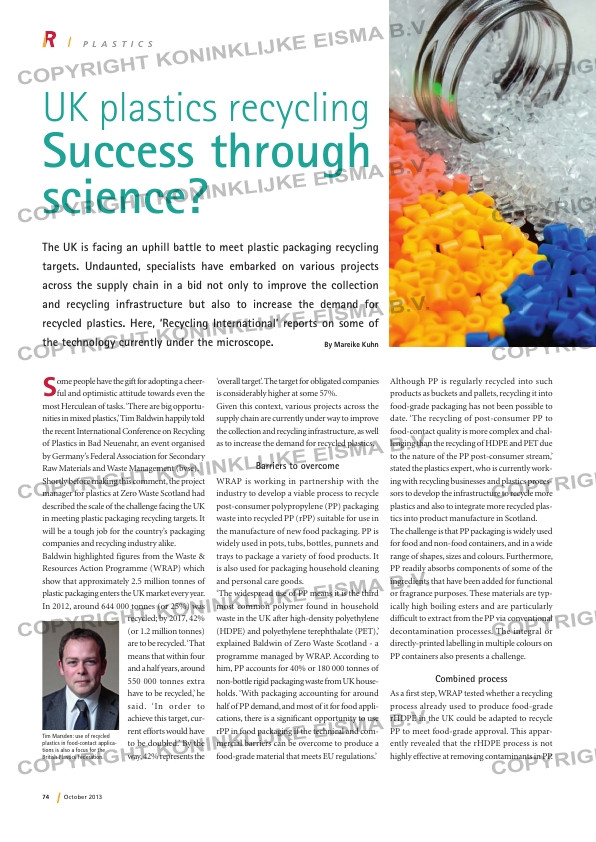Page 74 from: October 2013

74 October 2013
The UK is facing an uphill battle to meet plastic packaging recycling
targets. Undaunted, specialists have embarked on various projects
across the supply chain in a bid not only to improve the collection
and recycling infrastructure but also to increase the demand for
recycled plastics. Here, ‘Recycling International’ reports on some of
the technology currently under the microscope.
Some people have the gift for adopting a cheer-ful and optimistic attitude towards even the
most Herculean of tasks. ‘There are big opportu-
nities in mixed plastics,’ Tim Baldwin happily told
the recent International Conference on Recycling
of Plastics in Bad Neuenahr, an event organised
by Germany’s Federal Association for Secondary
Raw Materials and Waste Management (bvse).
Shortly before making this comment, the project
manager for plastics at Zero Waste Scotland had
described the scale of the challenge facing the UK
in meeting plastic packaging recycling targets. It
will be a tough job for the country’s packaging
companies and recycling industry alike.
Baldwin highlighted figures from the Waste &
Resources Action Programme (WRAP) which
show that approximately 2.5 million tonnes of
plastic packaging enters the UK market every year.
In 2012, around 644 000 tonnes (or 25%) was
recycled; by 2017, 42%
(or 1.2 million tonnes)
are to be recycled. ‘That
means that within four
and a half years, around
550 000 tonnes extra
have to be recycled,’ he
said. ‘In order to
achieve this target, cur-
rent efforts would have
to be doubled.’ By the
way, 42% represents the
‘overall target’. The target for obligated companies
is considerably higher at some 57%.
Given this context, various projects across the
supply chain are currently under way to improve
the collection and recycling infrastructure, as well
as to increase the demand for recycled plastics.
Barriers to overcome
WRAP is working in partnership with the
industry to develop a viable process to recycle
post-consumer polypropylene (PP) packaging
waste into recycled PP (rPP) suitable for use in
the manufacture of new food packaging. PP is
widely used in pots, tubs, bottles, punnets and
trays to package a variety of food products. It
is also used for packaging household cleaning
and personal care goods.
‘The widespread use of PP means it is the third
most common polymer found in household
waste in the UK after high-density polyethylene
(HDPE) and polyethylene terephthalate (PET),’
explained Baldwin of Zero Waste Scotland – a
programme managed by WRAP. According to
him, PP accounts for 40% or 180 000 tonnes of
non-bottle rigid packaging waste from UK house-
holds. ‘With packaging accounting for around
half of PP demand, and most of it for food appli-
cations, there is a significant opportunity to use
rPP in food packaging if the technical and com-
mercial barriers can be overcome to produce a
food-grade material that meets EU regulations.’
Although PP is regularly recycled into such
products as buckets and pallets, recycling it into
food-grade packaging has not been possible to
date. ‘The recycling of post-consumer PP to
food-contact quality is more complex and chal-
lenging than the recycling of HDPE and PET due
to the nature of the PP post-consumer stream,’
stated the plastics expert, who is currently work-
ing with recycling businesses and plastics proces-
sors to develop the infrastructure to recycle more
plastics and also to integrate more recycled plas-
tics into product manufacture in Scotland.
The challenge is that PP packaging is widely used
for food and non-food containers, and in a wide
range of shapes, sizes and colours. Furthermore,
PP readily absorbs components of some of the
ingredients that have been added for functional
or fragrance purposes. These materials are typ-
ically high boiling esters and are particularly
difficult to extract from the PP via conventional
decontamination processes. The integral or
directly-printed labelling in multiple colours on
PP containers also presents a challenge.
Combined process
As a first step, WRAP tested whether a recycling
process already used to produce food-grade
rHDPE in the UK could be adapted to recycle
PP to meet food-grade approval. This appar-
ently revealed that the rHDPE process is not
highly effective at removing contaminants in PP.
P L A S T I C S
By Mareike Kuhn
Tim Marsden: use of recycled
plastics in food-contact applica-
tions is also a focus for the
British Plastics Federation.
UK plastics recycling
Success through
science?
p00_Plastics UK.indd 74 03-10-13 10:09



